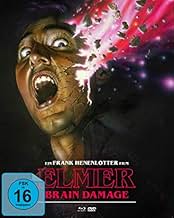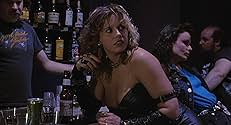VALUTAZIONE IMDb
6,5/10
13.684
LA TUA VALUTAZIONE
Un giovane scopre che una mostruosa creatura si è attaccata alla base del suo cervello, iniettando una sostanza con effetti euforici in cambio di vittime umane.Un giovane scopre che una mostruosa creatura si è attaccata alla base del suo cervello, iniettando una sostanza con effetti euforici in cambio di vittime umane.Un giovane scopre che una mostruosa creatura si è attaccata alla base del suo cervello, iniettando una sostanza con effetti euforici in cambio di vittime umane.
- Premi
- 1 candidatura
Rick Hearst
- Brian
- (as Rick Herbst)
Joseph Gonzalez
- Guy in Shower
- (as Joe Gonzales)
Ari M. Roussimoff
- Biker
- (as Ari Roussimoff)
Trama
Lo sapevi?
- QuizDuring the fellatio scene, the crew walked out on the production refusing to take part. A similar incident happened during the shooting of Basket Case (1982).
- BlooperWhen Brian wakes up bloody, the blood on his left hand disappears and reappears between shots.
- Curiosità sui creditiIn the end titles, listed under "Historical Research" is BABE WOZENTHAL. According Frank Henenlotter on the DVD's commentary, this was a joke about Jerry Lewis in "The Errand Boy."
- Versioni alternativeParamount video release deletes the gory nightclub fellatio and ear-pulling scenes to avoid an 'X' rating.
- ConnessioniFeatured in Cinemassacre's Monster Madness: Brain Damage (2010)
- Colonne sonoreCorruption
by J. Calder, A. Boston, J.E. Garnett, B. Elsey, & B. Burton
Performed by The Swimming Pool Q's
Courtesy of Irving Music, Inc.
Recensione in evidenza
One morning a young man (Rick Hearst) wakes to find a small, disgusting creature has attached itself to the base of his brain stem. The creature gives him a euphoric state of happiness but in return demands human victims.
After "Basket Case", Frank Henenlotter wanted to do a project called "Insect City", but that fell through due to funding and other issues... so he instead went for a twist on 1950s science fiction. He posited the idea: what if someone had a parasite, but one they actually wanted? This is an interesting concept, and was fleshed out to the idea of an "aylmer", this creature that was passed down from great ruler to great ruler for centuries. The story was so well-written that you feel it must have been at least partially based on some legend. Nope, just Henenlotter's genius.
The film is now widely seen as a metaphor for drug addiction, or addiction in general. But interestingly, this seems to be an afterthought. Henenlotter said the idea came to him like this: first, he thought of a creature attached to someone who needs to kill. But then, going with the concept of a "welcome" parasite, he wondered why the host would allow this, so he came up with the drug aspect. So rather than this being a story about the side effects of drugs, it is actually quite the other way around...
And, of course, as a selling point we have Henenlotter gore. While this film ranks beneath "Basket Case" and "Frankenhooker" as far as overall quality, it has some of the best gore... with scenes that had to be cut (for both the MPAA and the distributor!) but have since resurfaced. For those who love extreme films, the alley scene can only be enjoyed uncut.
As a bonus for horror fans, we even have the voice of Zacherle. Interestingly, Zacherle worked uncredited because he was in SAG and could not be in a non-union film at the risk of getting fined or tossed out of the union. His voice being so recognizable, some saw his lack of credit as an insult, but just the opposite was true: to give him credit would have opened him up to great punishment!
The legacy of "Brain Damage" cannot be ignored. Like all other Henenlotter films, it has acquired a cult following. Not as much as "Basket Case", but more so than "Bad Biology". And lead actor Rick Hearst has done well for himself, going from this independent production to becoming the king of daytime television, becoming a regular on no fewer than five soap operas! Quite the change of pace from low budget gore.
But most interesting is probably editor James Kwei, whom most people have never heard of. Kewi had been in horror for a while with "Christmas Evil", "Maximum Overdrive" and others. But after this, he increasingly became associated with the films of Martin Scorsese, including "Goodfellas". While he had already been with Scorsese since "After Hours" (1985), it was at this point (1988) where he really switched gears.
The Arrow Video Blu-ray is crammed fuller than Mr. Creosote. There is a brand new audio commentary by Frank Henenlotter and several featurettes. We have "Listen to the Light: The Making of Brain Damage", a brand new documentary featuring interviews with actor Rick Herbst, producer Edgar Ievins, editor James Kwei, first assistant director Gregory Lamberson, visual effects supervisor Al Magliochetti and makeup artist Dan Frye. There is "The Effects of Brain Damage" with FX artist Gabe Bartalos, and "A Look Back" with assistant editor Karen Ogle.
And still more... "Elmer's Turf: The NYC Locations of Brain Damage", sort of a supplement to the tour Henenlotter gives on the "Basket Case" Blu-ray. The interesting "Tasty Memories: A Brain Damage Obsession" interview with superfan Adam Skinner. A "Brain Damage" Q&A with Henenlotter recorded at the 2016 Offscreen Film Festival. And certainly not least of all, "Bygone Behemoth" (2010), an animated short by Harry Chaskin, featuring a brief appearance by John Zacherle in his final on screen credit.
After "Basket Case", Frank Henenlotter wanted to do a project called "Insect City", but that fell through due to funding and other issues... so he instead went for a twist on 1950s science fiction. He posited the idea: what if someone had a parasite, but one they actually wanted? This is an interesting concept, and was fleshed out to the idea of an "aylmer", this creature that was passed down from great ruler to great ruler for centuries. The story was so well-written that you feel it must have been at least partially based on some legend. Nope, just Henenlotter's genius.
The film is now widely seen as a metaphor for drug addiction, or addiction in general. But interestingly, this seems to be an afterthought. Henenlotter said the idea came to him like this: first, he thought of a creature attached to someone who needs to kill. But then, going with the concept of a "welcome" parasite, he wondered why the host would allow this, so he came up with the drug aspect. So rather than this being a story about the side effects of drugs, it is actually quite the other way around...
And, of course, as a selling point we have Henenlotter gore. While this film ranks beneath "Basket Case" and "Frankenhooker" as far as overall quality, it has some of the best gore... with scenes that had to be cut (for both the MPAA and the distributor!) but have since resurfaced. For those who love extreme films, the alley scene can only be enjoyed uncut.
As a bonus for horror fans, we even have the voice of Zacherle. Interestingly, Zacherle worked uncredited because he was in SAG and could not be in a non-union film at the risk of getting fined or tossed out of the union. His voice being so recognizable, some saw his lack of credit as an insult, but just the opposite was true: to give him credit would have opened him up to great punishment!
The legacy of "Brain Damage" cannot be ignored. Like all other Henenlotter films, it has acquired a cult following. Not as much as "Basket Case", but more so than "Bad Biology". And lead actor Rick Hearst has done well for himself, going from this independent production to becoming the king of daytime television, becoming a regular on no fewer than five soap operas! Quite the change of pace from low budget gore.
But most interesting is probably editor James Kwei, whom most people have never heard of. Kewi had been in horror for a while with "Christmas Evil", "Maximum Overdrive" and others. But after this, he increasingly became associated with the films of Martin Scorsese, including "Goodfellas". While he had already been with Scorsese since "After Hours" (1985), it was at this point (1988) where he really switched gears.
The Arrow Video Blu-ray is crammed fuller than Mr. Creosote. There is a brand new audio commentary by Frank Henenlotter and several featurettes. We have "Listen to the Light: The Making of Brain Damage", a brand new documentary featuring interviews with actor Rick Herbst, producer Edgar Ievins, editor James Kwei, first assistant director Gregory Lamberson, visual effects supervisor Al Magliochetti and makeup artist Dan Frye. There is "The Effects of Brain Damage" with FX artist Gabe Bartalos, and "A Look Back" with assistant editor Karen Ogle.
And still more... "Elmer's Turf: The NYC Locations of Brain Damage", sort of a supplement to the tour Henenlotter gives on the "Basket Case" Blu-ray. The interesting "Tasty Memories: A Brain Damage Obsession" interview with superfan Adam Skinner. A "Brain Damage" Q&A with Henenlotter recorded at the 2016 Offscreen Film Festival. And certainly not least of all, "Bygone Behemoth" (2010), an animated short by Harry Chaskin, featuring a brief appearance by John Zacherle in his final on screen credit.
I più visti
Accedi per valutare e creare un elenco di titoli salvati per ottenere consigli personalizzati
Dettagli
Botteghino
- Budget
- 900.000 USD (previsto)
Contribuisci a questa pagina
Suggerisci una modifica o aggiungi i contenuti mancanti

Divario superiore
By what name was Brain Damage (La maledizione di Elmer) (1988) officially released in India in English?
Rispondi































